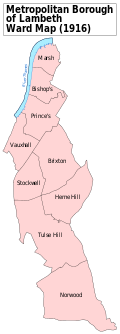| Lambeth North | |
|---|---|
| Former borough constituency for the House of Commons | |
 Lambeth North in London 1885-1918 | |
 Lambeth North in London 1918-50 | |
| County | Greater London |
| 1885–1950 | |
| Seats | One |
| Created from | Lambeth |
| Replaced by | Vauxhall |
Lambeth North was a borough constituency centred on the Lambeth district of South London. It returned one Member of Parliament (MP) to the House of Commons of the Parliament of the United Kingdom, elected by the first past the post system.






